If you’re a creator, selling courses, running coaching sessions, or managing workshops, you already know how overwhelming it can be to do it all. Content, emails, leads, follow-ups and that’s just Monday.
That’s where marketing automation becomes your best ally. In 2025, it’s not just about being creative, it’s about being consistent, saving time, and showing up for your audience even when you’re busy.
But with so many tools out there, which ones are actually worth your time (and money)? In this guide, we’ll break down the best marketing automation tools for creators, covering features, use cases, pros, cons, and how to pick the one that works best for you.
Understanding Marketing Automation Tools and Their Benefits
Marketing automation refers to software and technology that automates repetitive marketing tasks, such as sending emails, scheduling social media posts, or managing ads. For content creators and online coaches, this means less time spent on manual work and more time focused on what you do best: creating content, coaching clients, and building your community.
Here’s a detailed breakdown of why marketing automation is a game-changer for creators:
- Time Savings: Automating tasks like email sequences, social media posts, or follow-ups frees up hours in your week. Imagine setting up a welcome email series for new subscribers or scheduling a month’s worth of Instagram posts in one go; automation handles it while you focus on creating videos or planning your next course.
- Consistency: Staying consistent is key to building an audience, but it’s tough when you’re juggling multiple platforms. Automation ensures your marketing efforts are regular and timely, like sending weekly newsletters or posting daily on social media, without you having to remember every detail.
- Personalization: Advanced tools let you segment your audience and deliver tailored content. For example, you could send motivational tips to free subscribers and exclusive course updates to paying students, increasing engagement and loyalty. Personalization builds stronger connections, which is vital for creators.
- Scalability: As your audience grows from hundreds to thousands, managing everything manually becomes impossible. Automation tools help you handle larger email lists, more social media followers, and complex campaigns without needing a big team. Whether you’re launching a course or hosting a webinar, automation scales with you.
- Analytics: Understanding what works is crucial for growth. Most tools provide detailed insights, like email open rates, social media engagement, or sales conversions. This data helps you tweak your strategies. For example, refining a call-to-action that’s not converting or doubling down on a popular Instagram Reel format.
Armed with this knowledge, you’re ready to explore the top tools. Let’s kick things off with all-in-one platforms that streamline your entire marketing operation from a single hub.
All-in-One Marketing Tools
When you’re handling everything yourself, like creating content, handling leads, sending emails, and launching products, switching between five different apps is a productivity killer. That’s where all-in-one marketing tools shine.
These platforms bring everything into one place: email marketing, social scheduling, CRM, landing pages, automation, and more. They’re especially useful for creators, coaches, and educators who want to stay organised without hiring a full team.
Below, we’ve rounded up the best platforms in 2025 that offer this kind of creator-friendly integration with clear pros and cons so you can choose what fits you best.
1. Exly
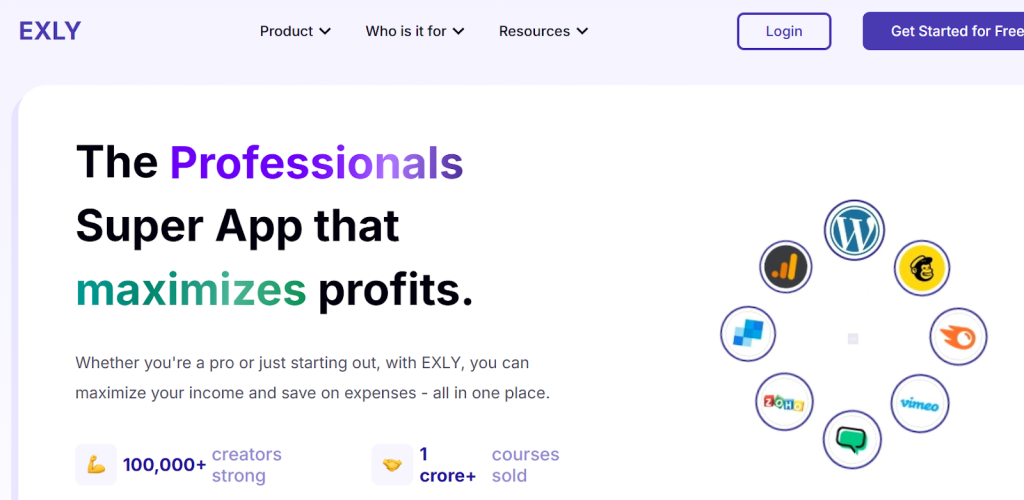
Exly is a homegrown gem tailored for Indian creators and coaches. It combines email marketing, social media scheduling, landing page creation, and CRM into one affordable dashboard. Whether you’re launching a fitness course or growing a YouTube following, Exly lets you manage it all without breaking the bank and with local support.
The CRM tracks leads, like webinar sign-ups or course inquiries, and automates follow-ups, keeping your audience engaged. Exly’s unique blend of simplicity and advanced features makes it ideal for beginners and experienced creators alike.
Best for: Creators and coaches who want a simple, affordable way to manage marketing and grow their audience.
- Pros:
- India-Centric: Seamlessly works with local payment systems and supports regional languages.
- All-in-One: Handles emails, social posts, CRM, and more from one place.
- User-Friendly: Intuitive design with templates to get you started fast.
- Budget Friendly
- Payments: Manage international and domestic payments with ease.
- Cons:
- Customization: Flexible, but may not fully meet super-niche needs.
- Pricing: Custom Pricing
2. Zoho Marketing Automation
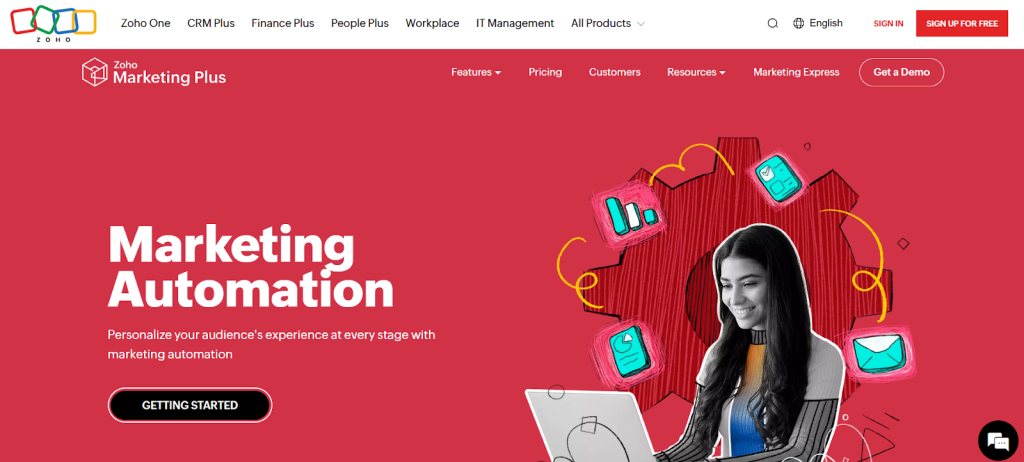
If you’re looking for a tool that balances affordability and functionality, Zoho Marketing Automation is worth a look. Part of the larger Zoho suite, it lets you manage email campaigns, schedule social posts, build landing pages, and even host webinars, all from one dashboard.
Its clean interface and beginner-friendly setup make it perfect for creators who want to start automating without getting overwhelmed. If you’re already using Zoho CRM or other Zoho tools, the integration is seamless.
Best for: Solo creators and small teams who want powerful tools on a budget.
- Pros:
- Zoho Ecosystem: Integrates smoothly with Zoho CRM and other apps, streamlining your workflow.
- User-Friendly: Drag-and-drop builders and a clean interface make it approachable for novices.
- Cons:
- Feature Depth: Limited advanced features like AI-based automation or deep analytics
- Customization: Basic customization, which may feel restrictive as your strategies grow
- Analytics: Reporting is decent, but lacks the in-depth insights offered by higher-end tools.
- Pricing: Starts at INR 855/month
3. Hubspot Marketing Hub
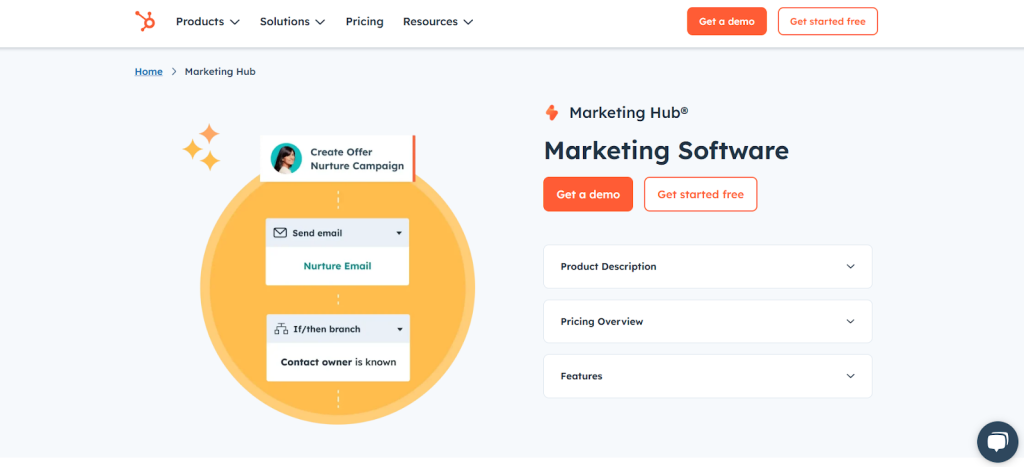
HubSpot Marketing Hub is built for inbound marketing, which is perfect if you focus on content, lead magnets, or driving organic traffic through blogs and landing pages. It combines email, social scheduling, SEO tools, and automation into one clean, beginner-friendly dashboard.
It also includes a free built-in CRM, making it easier to track leads, manage your funnel, and tie your content efforts to actual sales, all without jumping between tools. Plus, with HubSpot Academy’s free training, you don’t need to be a tech wizard to get started.
Best for: Creators and educators using content, webinars, or lead magnets to grow their audience.
Pros:
- Beginner-friendly interface, with tons of tutorials, templates, and walkthroughs
- Free CRM, great for tracking leads and customer journeys
- Built-in SEO and blogging tools, useful for growing your personal brand organically
Cons:
- Advanced features like multi-step automation and A/B testing are only available in higher plans
- May feel bloated for solo creators who just need simple email and funnel workflows
- Less control over customization, especially if you’re building niche journeys or want tailored logic
Pricing: Starts at around INR 1300/month ($15). A free plan is also available.
4. Oracle Eloqua Marketing Automation
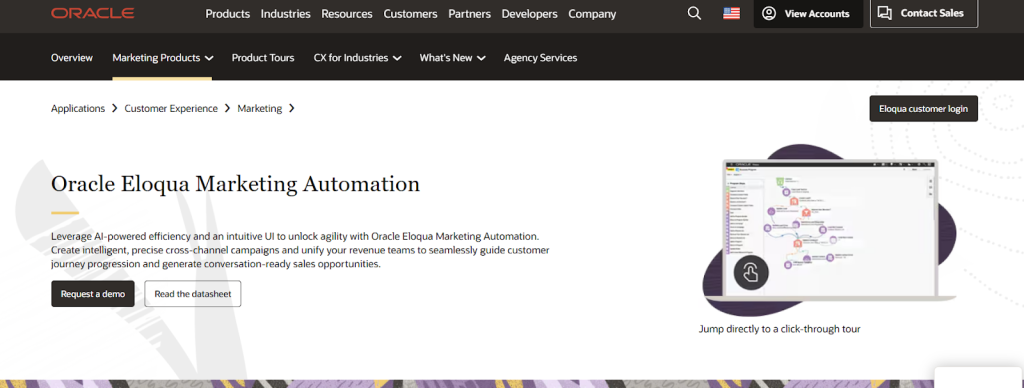
Oracle Eloqua is an enterprise go-to, offering deep segmentation, lead scoring, and cross-channel orchestration. It’s a beast for customization due to personalized workflows for ABM (account-based marketing) or global campaigns. Its reporting suite delivers granular insights to track every touchpoint.
For content creators, Eloqua’s precision is a plus, but its high starting price and steep learning curve make it best for established names with technical support. If you’re a high-profile coach, it’s a worthy investment; otherwise, it’s overkill.
- Best for: Big coaches and creators with technical expertise and intricate marketing playbooks.
- Pros:
- Customization: Build workflows as unique as your business, from lead scoring to event triggers.
- Analytics: Detailed reports help you dissect campaign performance with precision.
- Oracle Integration: Plays well with Oracle’s broader cloud suite for a cohesive tech stack.
- Cons:
- Complexity: Requires IT expertise to implement and manage, not a solo job.
- Price: Hefty investment (often $2,000+/month), out of reach for most small creators.
- Learning Curve: Steep ramp-up time can delay ROI without proper training.
- Pricing: Custom Pricing.
5. ActiveCampaign
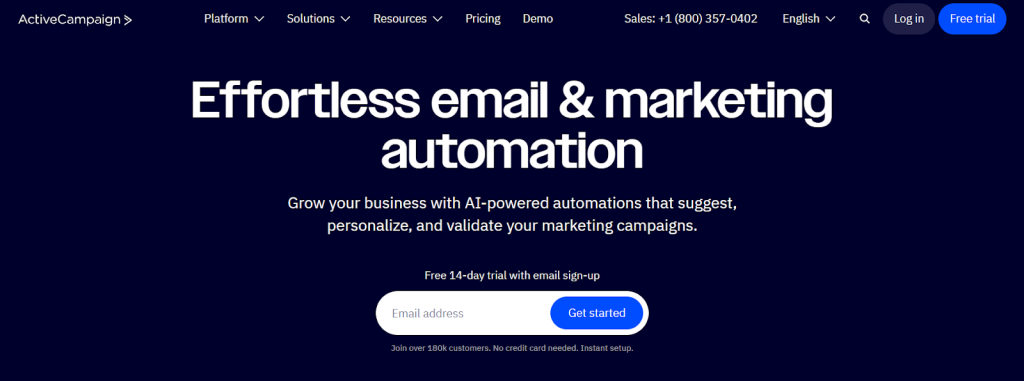
ActiveCampaign strikes a balance between power and simplicity, blending email marketing, CRM, and automation. It’s a favorite for its drag-and-drop automation builder and affordable plans. You’ll get tools for email sequences, sales funnels, and even basic SMS marketing.
Most creators and coaches would find its $15/month (around INR 1300) starting price a steal, and the built-in CRM tracks your audience’s journey. It’s ideal for solo creators or small teams, though it lacks high-end features for massive lists.
- Best for: Small to medium-sized creators craving versatility on a budget.
- Pros:
- Ease of Use: Intuitive automation builder lets you craft workflows fast as no coding is needed.
- CRM Integration: Built-in CRM ties marketing to sales without extra cost.
- Cons:
- Enterprise Limits: Misses high-end features like advanced segmentation for massive firms.
- Scalability: Fine for small creators but may strain under huge contact lists.
- Support: Responsive, but not as extensive as pricier platforms.
- Pricing: Starts at $15/month (around INR 1300)
6. Marketo Engage Marketing Automation

Marketo Engage, under Adobe’s umbrella, shines in lead management and data-driven marketing. It offers email automation, lead scoring, and ABM tools, all enhanced by Adobe Experience Cloud integration. It’s built for creators who thrive on insights and precision.
Large scale creators with big teams can hugely benefit from Marketo’s assortment of features. But at the same time, it’s high price can be an entry barrier for small and medium level coaches and creators.
- Best for: Large content creators focused on lead nurturing and analytics-heavy strategies.
- Pros:
- Lead Management: Sophisticated scoring and nurturing tools refine your funnel.
- Analytics: Deep reporting tracks performance across channels.
- Adobe Integration: Ties into Adobe’s ecosystem for a unified customer view.
- Cons:
- Complexity: Steep learning curve demands skilled users or training.
- Resources: Needs dedicated staff to maximize its potential.
- Pricing: Custom pricing, often $1,000+/month.
These all-in-one tools lay a strong foundation for your marketing efforts. Next, we’ll explore specialized platforms, starting with email marketing automation.
Email Marketing Automation Tools
Email marketing remains a cornerstone of digital strategy, and specialized automation tools can elevate your campaigns. Here’s a deep dive into the top email marketing automation tools for 2025, complete with their strengths and weaknesses.
1. Klaviyo

Klaviyo is a powerhouse for e-commerce, offering advanced segmentation, personalization, and integrations with platforms like Shopify and WooCommerce. It’s designed to turn customer data into targeted campaigns, making it one of the leading marketing automation tools.
Its drag-and-drop editor makes it accessible, while its analytics provide insights into revenue per email. Klaviyo is great for small and medium level content creators and coaches due to its payment gateway integrations, affordable pricing, and features like drag-and-drop editor.
- Best for: E-commerce creators and coaches focused on data-driven email marketing.
- Pros:
- E-commerce Integration: Syncs seamlessly with online stores for real-time data.
- Segmentation: Deep options to target customers based on behavior, purchase history, or demographics.
- Analytics: Tracks revenue and engagement, helping you optimize campaigns.
- Cons:
- Niche Focus: Less versatile for non-retail businesses.
- Learning Curve: Advanced features require time to master.
- Pricing: Starts at $20/month (around INR 1700), scaling with contact list size. A free plan is also available.
2. SendinBlue (Brevo)
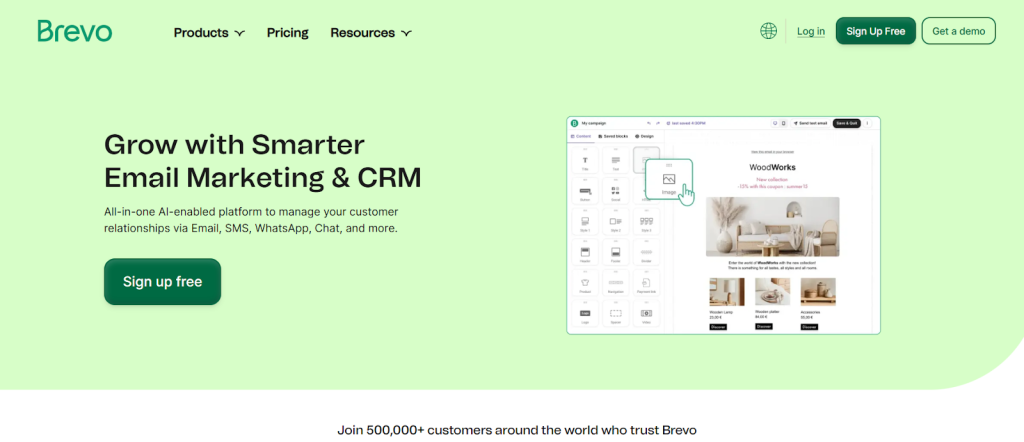
SendinBlue, recently rebranded as Brevo, is a budget-friendly gem for Indian creators and coaches who want to maximize impact without draining their wallets. It’s free tier allows you to send up to 300 emails a day, plenty to nurture a budding audience of followers or students.
What makes it stand out in the Indian market is its SMS marketing feature. With mobile usage skyrocketing in India, you can send quick reminders about your live coaching sessions or flash sales on your latest course directly to your audience’s phones, tapping into the SMS and WhatsApp culture.
- Best for: Small creators and coaches needing affordable, straightforward tools.
- Pros:
- Free Plan: Send up to 300 emails daily at no cost.
- Ease of Use: Simple drag-and-drop builder for quick campaign creation.
- SMS Marketing: Adds an extra channel for outreach.
- Cons:
- Limited Features: Advanced automation and analytics are locked behind paid plans.
- Scalability: Not ideal for large enterprises with complex needs.
- Support: Basic support on lower tiers; premium options cost extra.
- Pricing: The plan starts at $8/month (around INR 700) and scales with the size of the contact list. A free plan is also available.
3. GetResponse

GetResponse is a versatile all-in-one solution for Indian coaches and creators who juggle multiple hats like email campaigns, webinars, and course sales. Its standout feature is the webinar integration, letting you host and promote online workshops directly from the platform.
For coaches running live sessions or creators launching masterclasses, this means streamlined registration pages and automated reminders, keeping your audience engaged without the tech overwhelm.
- Best for: Coaches and creators blending email marketing with webinars or online sales.
- Pros:
- Webinar Integration: Host and promote webinars directly from the platform.
- Landing Pages: Create conversion-focused pages without extra tools.
- E-commerce Tools: Sell products and track sales within the app.
- Cons:
- Limited features: Most features are in the higher tiered plans.
- Complexity: Steeper learning curve for non-marketers.
- Email Limits: Lower plans cap monthly sends, which can be restrictive.
- Pricing: The basic plan starts at INR 1325.
4. MailChimp

MailChimp is a household name, known for its free plan and beginner-friendly interface. It offers email marketing, basic automation, and even website building. While it’s great for small businesses and creators, its advanced features are limited, making it less suitable for complex strategies.
MailChimp also offers basic automation like welcome series or birthday greetings, plus a simple website builder to showcase your coaching services or content. This makes it a great fit if you’re just starting to monetize your work. That said, as your audience grows, you might bump into limitations. Still, it’s a reliable, budget-friendly starting point.
- Best for: Beginners and small creators needing simple, cost-effective tools.
- Pros:
- Free Tier: Send up to 10,000 emails monthly to 2,000 contacts.
- Ease of Use: Intuitive design with plenty of templates.
- Integrations: Connects with hundreds of apps via its marketplace.
- Cons:
- Feature Depth: Lacks advanced automation and segmentation.
- Scalability: Costs rise quickly as your list grows.
- Support: Limited on free and lower plans.
- Pricing: The cheapest plan starts at INR 550, which allows 6000 emails each month to 500 contacts.
5. Omnisend
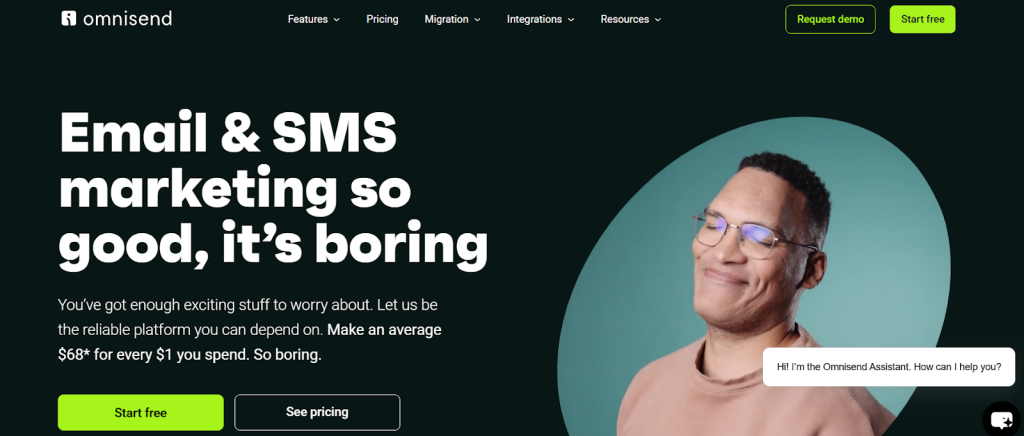
Omnisend is billed as an e-commerce tool, but it’s a secret weapon for content creators and coaches selling digital products like courses or eBooks. It’s an omnichannel powerhouse, mixing email, SMS, and push notifications to keep your audience hooked.
It integrates with platforms like BigCommerce and Magento, and its automation workflows are pre-built for common retail scenarios, like cart recovery or product recommendations. There’s a learning curve to learn its features, but for creators ready to step up their game, the results speak for themselves.
- Best for: Online creators and coaches selling digital products who want to go beyond email.
- Pros:
- Omnichannel: Reach customers via email, SMS, and web push.
- Pre-Built Workflows: Save time with templates for common e-commerce triggers.
- Segmentation: Target customers based on shopping behavior.
- Cons:
- Niche Focus: Less effective for non-e-commerce businesses.
- Learning Curve: Some features require technical setup.
- Pricing: Starts at $11/month (around INR 1000), scaling with features and contacts.
With email marketing covered, let’s turn to tools that streamline your social media efforts.
Social Media Automation Tools
Social media marketing automation tools help you schedule posts, track engagement, and manage multiple accounts efficiently.
Here’s a detailed look at the top picks for 2025.
1. Buffer
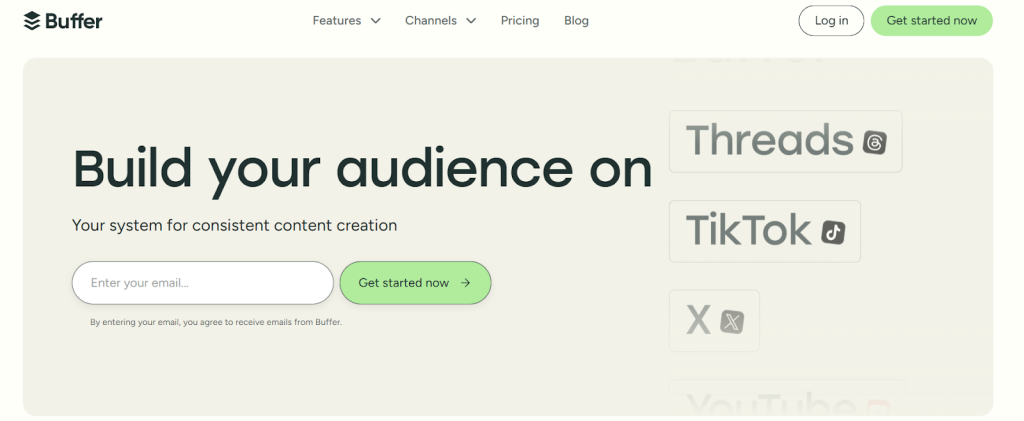
Buffer is a straightforward tool for scheduling posts across platforms like Instagram, Twitter, and LinkedIn. It offers basic analytics and a clean interface, making it ideal for individuals or small teams. Its free plan is a budget-saver, offering 10 scheduled posts across three accounts.
Paid plans start at just $5/month. It’s light on advanced analytics and engagement tools, but the mobile app keeps you in control wherever you are.
- Best for: Solopreneurs and small creators needing simple scheduling.
- Pros:
- Ease of Use: Intuitive design with minimal setup.
- Affordability: Paid plans start at $5/month and a free plan is also available.
- Cons:
- Limited Features: Lacks advanced analytics or social listening.
- Scalability: Not built for large teams or complex strategies.
- Engagement Tools: Basic; no inbox for managing comments.
- Pricing: Starts at $5/month (around INR 500) and a free plan with limited features is also available.
2. Sprout Social
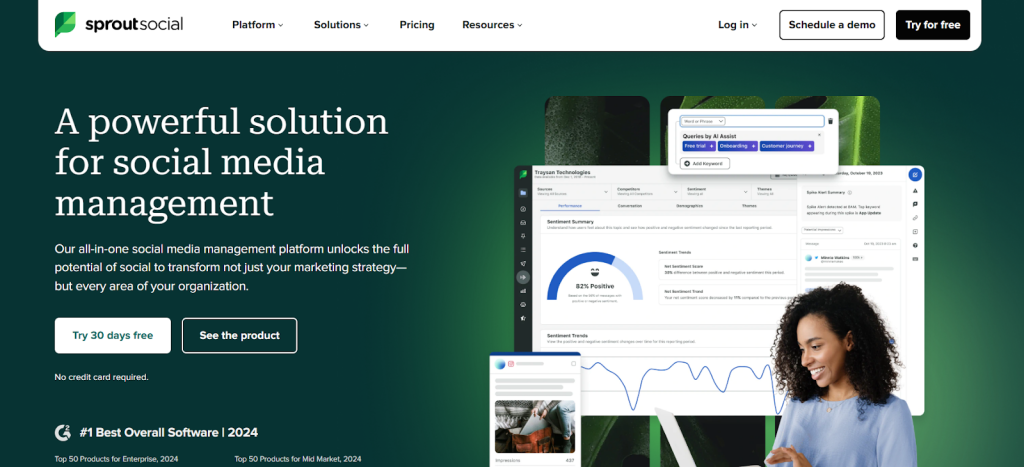
Sprout Social is a comprehensive platform with scheduling, detailed analytics, and social listening to track what people are saying about your brand. For coaches or content studios managing multiple accounts, its shared calendars and approval workflows keep everyone aligned.
The catch? It starts at $199 per user per month, which can be a big jump for solo creators. But if you’re running a coaching business or agency, the investment pays off with insights that help you fine-tune your strategy. The learning curve is real, but for those serious about social media, it’s a powerhouse worth considering.
- Best for: Medium to large creators and coaches with active social strategies.
- Pros:
- Analytics: In-depth reports on engagement and audience growth.
- Team Features: Assign tasks and manage approvals seamlessly.
- Social Listening: Track brand mentions and trends.
- Cons:
- Complexity: Steeper learning curve for beginners.
- Free Trial: Limited to 30 days; no free plan.
- Pricing: Starts at $199/user/month, which can add up quickly.
3. Loomly
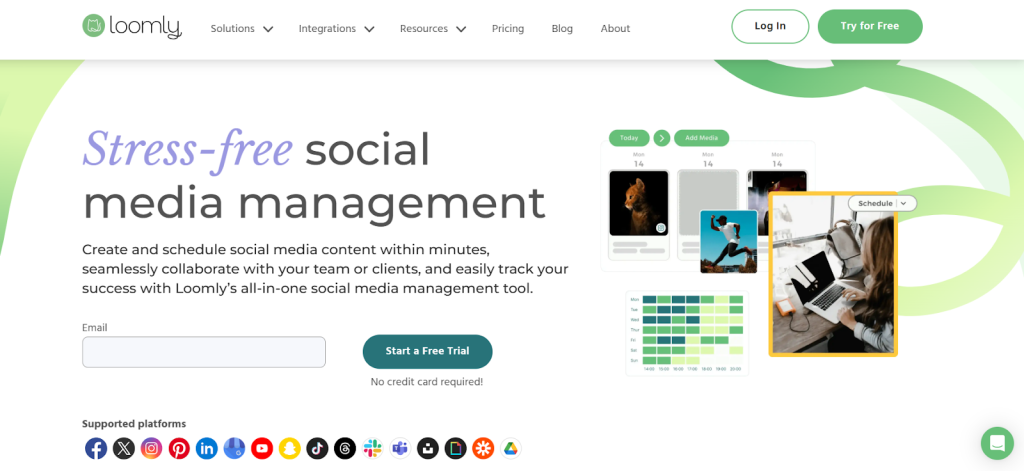
Loomly focuses on content planning with a visual calendar, post ideas, and collaboration tools. It’s affordable and intuitive, making it great for small to medium-sized creator teams.
You can assign tasks and gather feedback within the platform, streamlining your workflow. Analytics are decent but not as robust as pricier tools, still, it’s enough to gauge what’s working. Loomly balances cost and creativity perfectly for growing brands.
- Best for: Creators and coaches needing help with content ideation and scheduling.
- Pros:
- Content Suggestions: Get post ideas based on trends or holidays.
- Visual Calendar: Plan and preview posts easily.
- Cons:
- Analytics: Less detailed than competitors like Sprout Social.
- Custom Pricing: Can go into thousands of dollars.
- Platform Support: Limited to major networks; no niche platforms.
- Advanced Features: Lacks social listening or inbox management.
- Pricing: Custom pricing with a free plan also available.
4. ContentStudio
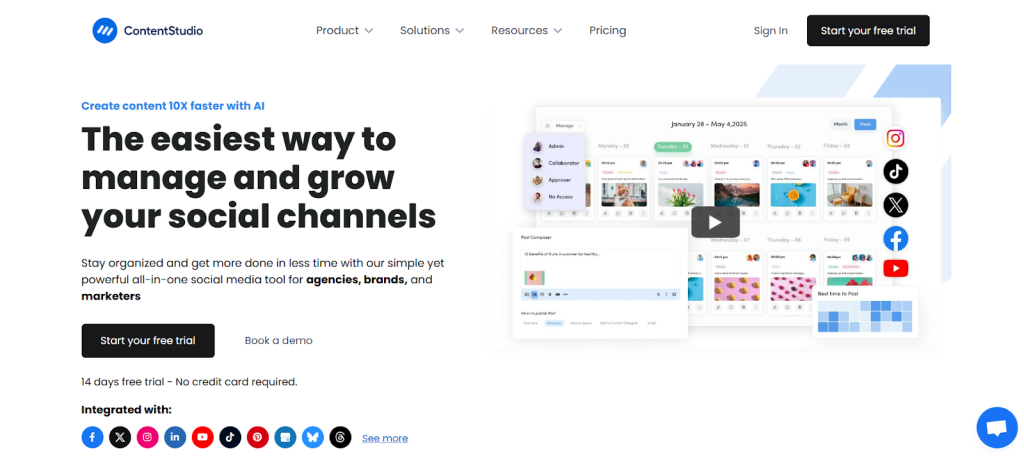
ContentStudio blends content discovery, curation, and scheduling. It’s a gem for creators prioritizing content marketing, with tools to find trending articles and automate posts. Its analytics track performance across channels. For coaches aiming to be thought leaders, this is a fast track to curating content that builds trust.
It also handles scheduling, posting at peak times automatically, and tracks how your efforts perform across platforms. Collaboration features are lighter, so it’s best for those managing their own show, but the content focus makes it a standout.
- Best for: Creators and coaches who lean on content marketing and automation.
- Pros:
- Content Discovery: Find and share relevant articles easily.
- Automation: Schedule posts based on optimal times.
- Analytics: Track engagement and ROI.
- Cons:
- Collaboration: Less robust for large teams.
- Learning Curve: Takes time to master all tools.
- Pricing: Starts at $19/month (around INR 1700), scaling with features.
5. Hootsuite
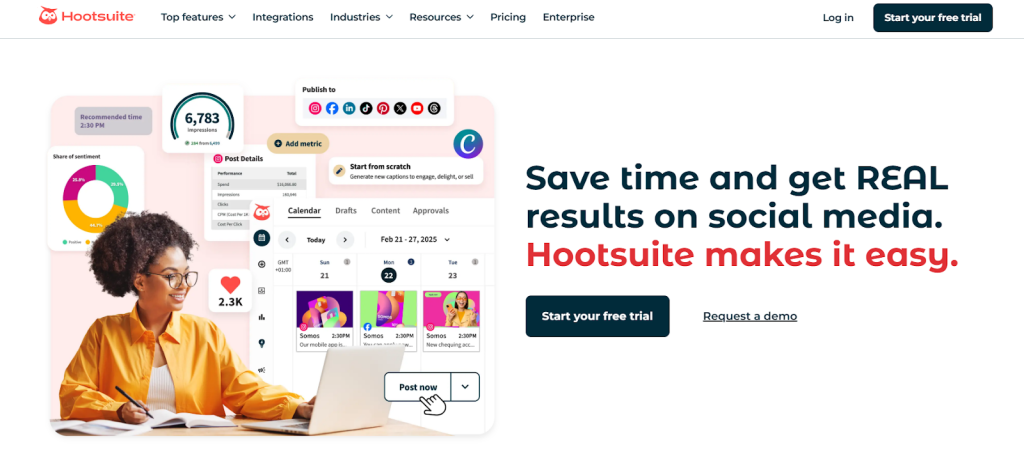
Hootsuite is a veteran in social media management, offering scheduling, analytics, and team collaboration. It scales well for medium to large businesses, with support for over 35 networks. Its app directory adds extra functionality.
Its team features let you delegate tasks and monitor activity, while the app directory connects to tools like your CRM for a custom setup. The downside? The interface feels a bit old-school and cluttered. But for creators ready to scale across platforms, Hootsuite’s reliability and flexibility make it a solid pick.
- Best for: Creators and coaches handling multiple accounts across diverse platforms. If you need a tool that grows with your vision, Hootsuite’s worth it.
- Pros:
- Platform Support: Handles major and niche networks.
- Team Tools: Assign tasks and monitor team activity.
- App Directory: Extend features with third-party integrations.
- Cons:
- Interface: Can feel cluttered and dated.
- Learning Curve: Steeper for new users.
- Pricing: Starts at 1,915/month per user, with costs rising for more users.
With social media streamlined, let’s explore tools that help you map and automate your customer journey.
Customer Journey Automation (Mapping) Tools
Understanding your customers’ journey is crucial, and these tools help you visualize and optimize it. They are slightly different from marketing automation tools as their primary function is to map and optimize this process, ensuring you connect with your followers at every step.
1. Smaply
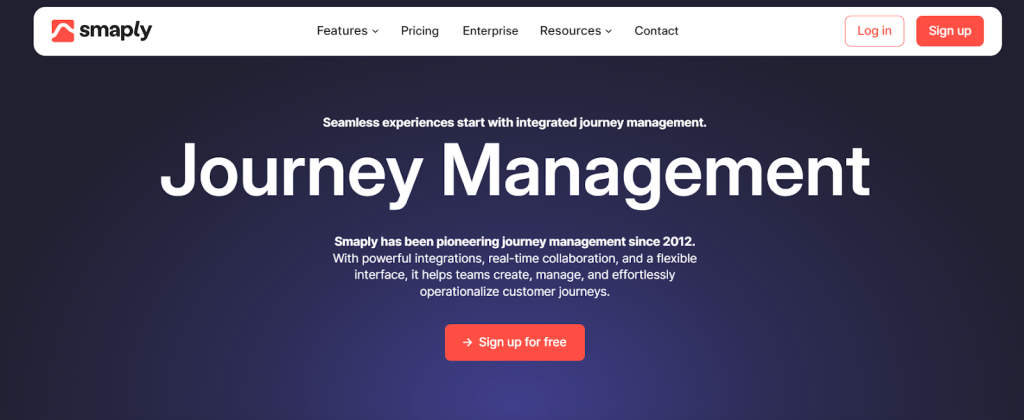
Smaply is a powerful journey mapping tool that’s perfect for Indian creators and coaches who want a clear picture of their audience’s experience. Its drag-and-drop interface is beginner-friendly, letting you map out how a viewer discovers your Instagram reel, subscribes to your channel, and eventually enrolls in your course.
Plus, its collaboration features allow you to share these maps with your virtual assistant or team, ensuring everyone understands your strategy. What makes Smaply stand out for Indian users is its persona creation tools. You can build detailed profiles of your typical clients.
- Best for: Creators and coaches who want to visually map their audience’s journey and refine their experience.
- Pros:
- Ease of Use: Intuitive design for quick mapping.
- Collaboration: Share maps and gather input easily.
- Persona Tools: Create detailed customer profiles.
- Free Plan: For basic use
- Cons:
- Automation: Limited; focuses on mapping, not execution.
- Scalability: Best for small to medium teams.
- Pricing: Starts at around $400/month.
2. Gliffy
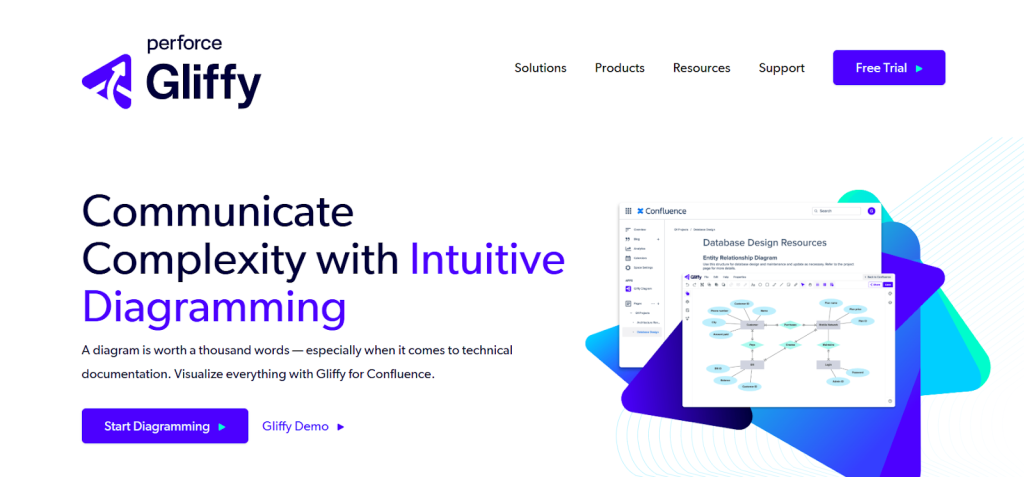
Gliffy is a general diagramming tool that can be adapted for journey mapping. It’s versatile and affordable, with templates for various diagrams. However, it requires extra effort to tailor it for customer journeys.
For those already using project management tools like Jira or Confluence, Gliffy integrates seamlessly, which is a bonus if you’re managing a small team across cities. However, it’s not purpose-built for journey mapping, so you’ll need to spend time customizing it to fit your needs.
- Best for: Content creators needing a flexible diagramming tool.
- Pros:
- Versatility: Use for flowcharts, org charts, and more.
- Affordability: Starts at $4/month for teams.
- Integration: Works with Jira and Confluence.
- Cons:
- Specialization: Not built for journey mapping; lacks specific features.
- Collaboration: Basic compared to dedicated tools.
- Learning Curve: Takes time to customize for marketing needs.
- Pricing: Starts at around $4/month per user. A free plan for up to 10 users is also available.
3. TheyDo
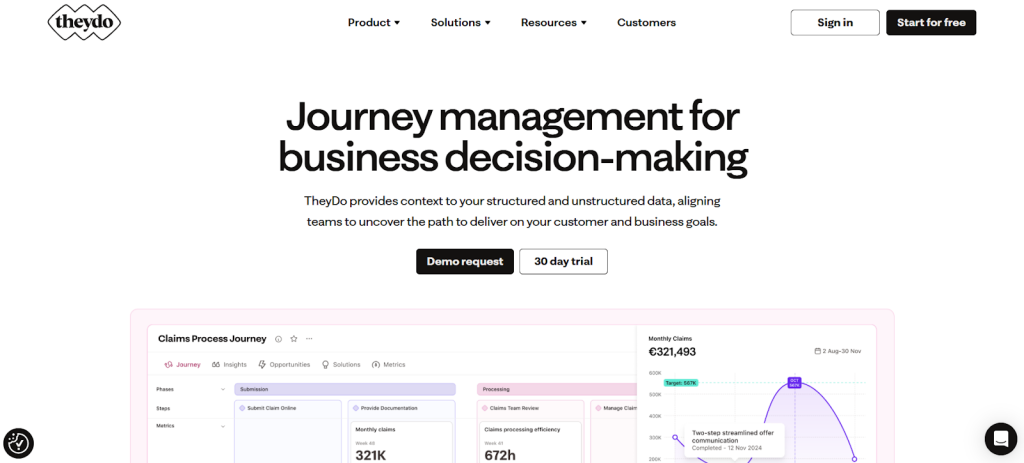
TheyDo is dedicated to journey management, offering mapping, collaboration, and integration with tools like Slack. It’s a specialized choice for creators and coaches invested in customer experience, with features to align teams around the journey.
The free plan gives you a taste of its capabilities, but the paid plans jump to $39,000, positioning TheyDo as a tool for established coaching businesses or content studios with bigger budgets. Its depth and complexity mean you’ll need to invest time in onboarding, but for those focused on perfecting every touchpoint with their audience, it’s a worthwhile trade-off.
- Best for: Organizations prioritizing customer journey optimization.
- Pros:
- Journey Focus: Built specifically for mapping and management.
- Collaboration: Real-time editing and feedback.
- Free Plan: Basic plan with limited features.
- Integration: Syncs with popular productivity apps.
- Cons:
- Complexity: May be overkill for simple needs.
- Onboarding: Requires training for full use.
- Pricing: Paid plans start at $39,000.
4. Leadsquared
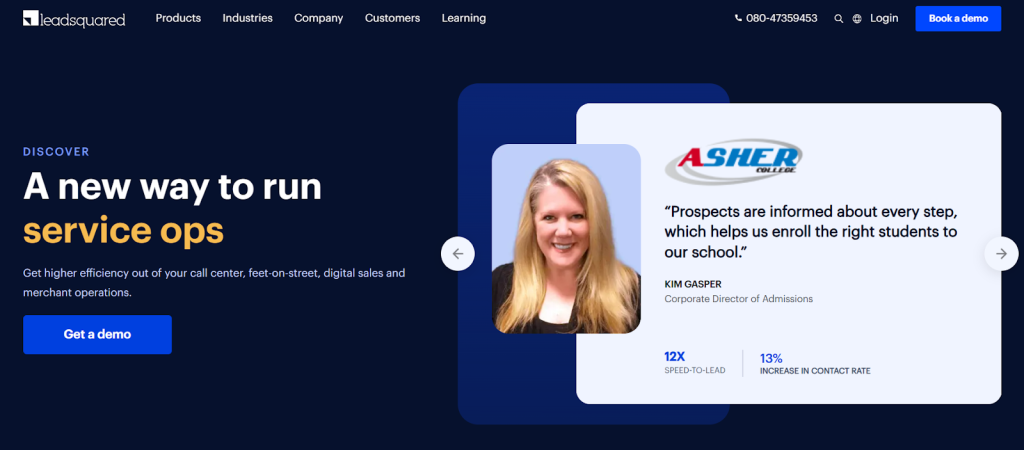
Leadsquared is a CRM with automation for sales and marketing. It’s less about mapping and more about execution, offering tools to automate lead nurturing and track interactions. For creators selling high-value courses or coaching, its sales-focused features can streamline your funnel.
The analytics dashboard is a highlight, showing you where leads drop off so you can tweak your approach, which is crucial for understanding Indian audiences with diverse needs. It’s less about brainstorming the journey and more about making it happen, which could be perfect for coaches ready to scale.
- Best for: Coaches and creators focused on lead conversion and sales automation.
- Pros:
- CRM Integration: Ties marketing to sales seamlessly.
- Automation: Strong workflows for lead management.
- Analytics: Track performance across the funnel.
- Cons:
- Mapping: Limited journey visualization tools.
- Customization: May need tweaks for specific use cases.
- Pricing: Starts at INR 90,000/month.
Now that you’ve got the customer journey covered, let’s look at tools to automate your advertising.
Advertising Automation Tools
Running ads manually can eat up your time and budget, especially when you’re managing everything solo. Advertising automation tools help you launch, test, and optimise campaigns across platforms like Facebook, Instagram, and Google without getting lost in the backend.
Here are the top picks for creators in 2025.
1. AdRoll

AdRoll is a retargeting and prospecting pro, originally designed for e-commerce but adaptable for creators pushing digital products like courses or coaching packages. Its integration with platforms like Shopify makes it easy to set up campaigns, while AI optimizes your budget.
The clear analytics dashboard lets you see which ads drive sign-ups, helping you refine your strategy. The custom pricing (based on ad spend) might deter smaller creators, but for those ready to invest in ads, AdRoll’s precision can boost conversions.
- Best for: Creators selling digital products who want retargeting power.
- Pros:
- E-commerce Integration: Syncs with major platforms.
- AI Optimization: Adjusts bids and targeting automatically.
- Analytics: Tracks ROI and customer acquisition costs.
- Cons:
- Niche Focus: Less effective for non-retail ads.
- Complexity: Takes time to master advanced features.
- Pricing: Custom pricing, scaling with ad spend.
2. Metadata.io
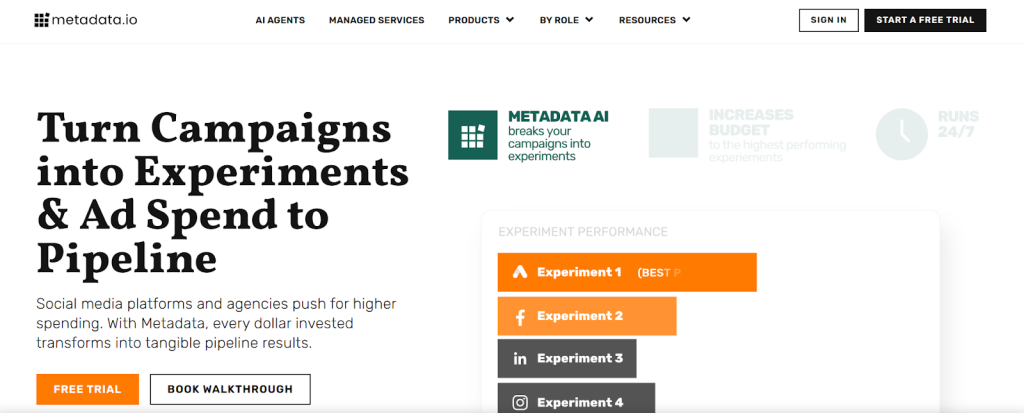
Metadata.io is a B2B advertising tool that uses AI to automate targeting and budget allocation across channels like LinkedIn and Facebook. For coaches offering corporate training or professional coaching, it helps you reach decision-makers efficiently. Its detailed analytics on lead quality and cost give you the data to fine-tune campaigns for better results.
If your audience includes businesses or professionals willing to pay premium rates, Metadata.io can help you scale your reach. Just be prepared for the technical setup and investment it demands.
- Best for: Coaches with B2B clients and bigger budgets.
- Pros:
- AI-Driven: Automates targeting and budget allocation.
- Multi-Channel: Manages ads across platforms.
- Analytics: Detailed reports on lead quality and cost.
- Cons:
- Technical Demands: Requires expertise to maximize.
- Scalability: Best for larger teams.
- Pricing: Custom pricing.
3. Revealbot (Birch)

Revealbot (Birch) is all about automating social media ads, focusing on Facebook and Instagram. Its rules-based automation lets you set triggers, like pausing ads that underperform or scaling ones that click, saving you hours of manual tweaks. The real-time analytics keep you in the loop so that you can adjust on the go.
It’s an accessible entry point for creators ready to test ad automation without a huge commitment. However, it’s limited to social channels, so if you’re advertising on Google or elsewhere, you’ll need another tool. For those leaning heavily on Instagram reels or Facebook lives, Revealbot’s simplicity is a win.
- Best for: Content creators focused on social media advertising.
- Pros:
- Automation Rules: Set triggers to manage ads automatically.
- Analytics: Track performance and optimize in real-time.
- Ease of Use: Intuitive interface for quick setup.
- Cons:
- Platform Limits: Only supports social channels.
- Features: Lacks broader ad network support.
- Pricing: Starts at $45/month, scaling with ad spend.
With these tools in your arsenal, it’s time to bring it all together.
How to Choose Marketing Automation Tools
Selecting a marketing automation tool isn’t a one-size-fits-all decision; it’s about aligning the platform with your unique needs. Here’s a detailed rundown of the key factors to consider before you commit:
Business Size and Needs
Your company’s scale and objectives shape your requirements. A small business might need a straightforward tool to nurture leads via email, like sending welcome sequences to new subscribers.
Meanwhile, a global enterprise might require a robust system for orchestrating multi-channel campaigns, such as email, social ads, and SMS, all tied to advanced analytics. Ask yourself: What’s your biggest pain point? If it’s lead generation, prioritize tools with strong CRM integration. If it’s brand awareness, look for social media capabilities.
Budget
Pricing varies wildly, from free tiers to premium plans costing thousands monthly. A small team might thrive on a $20/month tool, but a larger operation could justify a $1,000+ investment for enterprise-grade features.
Don’t just chase the lowest price. Cheap tools might skimp on essentials like reporting, while overpriced ones could burden you with unused extras. Map out your budget and match it to the value you’ll actually use.
Ease of Use
The best automation tool is the one you actually use. The right marketing automation tool should feel like a co-pilot, not a technical headache. Prioritise platforms with clean, intuitive interfaces that don’t require a tech team to set up. Tools with drag-and-drop builders (like ConvertKit’s visual automation or Mailchimp’s customer journey builder) make it easy to visually map out your email flows or lead magnets.
Also, look for tools that offer creator-friendly onboarding, such as step-by-step video tutorials, in-app walkthroughs, and pre-built templates for course funnels, lead magnets, and workshop launches. AI-powered suggestions that write email copy or automate workflows can be a huge bonus, especially if you’re doing this solo.
Integration Capabilities
No tool exists in a vacuum. It needs to sync with your current stack, including your CRM (like Salesforce or Pipedrive), e-commerce platform (Shopify, WooCommerce), or analytics software (Google Analytics). Seamless integrations prevent data silos and manual workarounds.
Imagine a scenario where your email tool can’t talk to your CRM. Suddenly, you’re exporting spreadsheets instead of automating follow-ups. Check compatibility before you buy.
Scalability
You might be starting with a few hundred followers, but that won’t last long, not if you’re serious about turning content into income. Whether you’re growing your email list, launching your third course, or running workshops for 100+ people, your marketing tool should grow with you, without breaking the bank
Look for platforms that can scale from solo to six figures, with flexible pricing, high subscriber limits, and features like smart segmentation for different audience types (freebies, buyers, loyal fans). Tools that support multi-channel campaigns, email, WhatsApp, Instagram DMs, and even webinars, help you meet your audience wherever they hang out.
Bonus if the tool has built-in options for collaboration (if you hire a VA or teammate later), with role-based access, reusable templates, and automations that keep things running even when you’re offline.
Customer Support
Tech glitches hit when you least expect them. Maybe it’s right before your webinar or during a product launch. And when you’re a solo creator, there’s no IT team to jump in. That’s why fast, reliable support is not optional. It’s essential.
Choose tools that offer responsive customer support, ideally with 24/7 live chat, helpful video tutorials, or an active creator community. Platforms with detailed FAQs, WhatsApp support, or email responses within hours (not days) can save your launch when things go sideways.
Imagine your Diwali sale campaign getting stuck, and the help desk takes two days to reply. That’s lost revenue and lost trust. Solid support means you can fix problems quickly and get back to doing what you do best: creating and selling.
Conclusion
In 2025, the right marketing automation tool can be a game-changer, but the key is finding one that fits your specific goals, budget, and team. Whether you need a versatile all-in-one like Hubspot, a specialized email tool like Klaviyo, or a social media manager like Sprout Social, this guide has you covered.
Take your time, weigh the pros and cons, and choose a platform that not only meets your current needs but also scales with your ambitions. Looking for a seamless way to manage your marketing and grow your business? Exly’s all-in-one platform simplifies your workflow, from automation to analytics. Start with Exly today.
FAQs About Marketing Automation Tools for 2025
1. Why should I invest in marketing automation tools for my business?
Marketing automation tools save time, reduce errors, and boost efficiency, with studies predicting a 14.5% sales productivity increase by 2025. They streamline tasks like email campaigns and social posts, letting you focus on strategy and growth.
2. How do I choose between an all-in-one tool and a specialized one?
Assess your needs: all-in-one tools like Hubspot suit broad campaigns, while specialized ones like Klaviyo excel for specific channels like email. If budget and simplicity matter, start specialized; if scale is key, go all-in-one.
3. Are marketing automation tools suitable for small businesses?
Yes, tools like SendinBlue and ActiveCampaign offer free or low-cost plans tailored for small teams. They provide core features like email automation and basic analytics, making automation accessible without breaking the bank.
4. What’s the biggest mistake to avoid when using these tools?
Overcomplicating workflows or neglecting setup can lead to errors or disuse. Start with one task, like automating welcome emails, and test thoroughly. Platforms like Exly simplify setup with intuitive interfaces and support.
5. How can I ensure my team adopts a new automation tool?
Choose a user-friendly tool with solid onboarding resources, like video tutorials or live support. Involve your team early, gather their input, and run pilot campaigns to build confidence. Exly’s platform, for example, offers seamless training.





